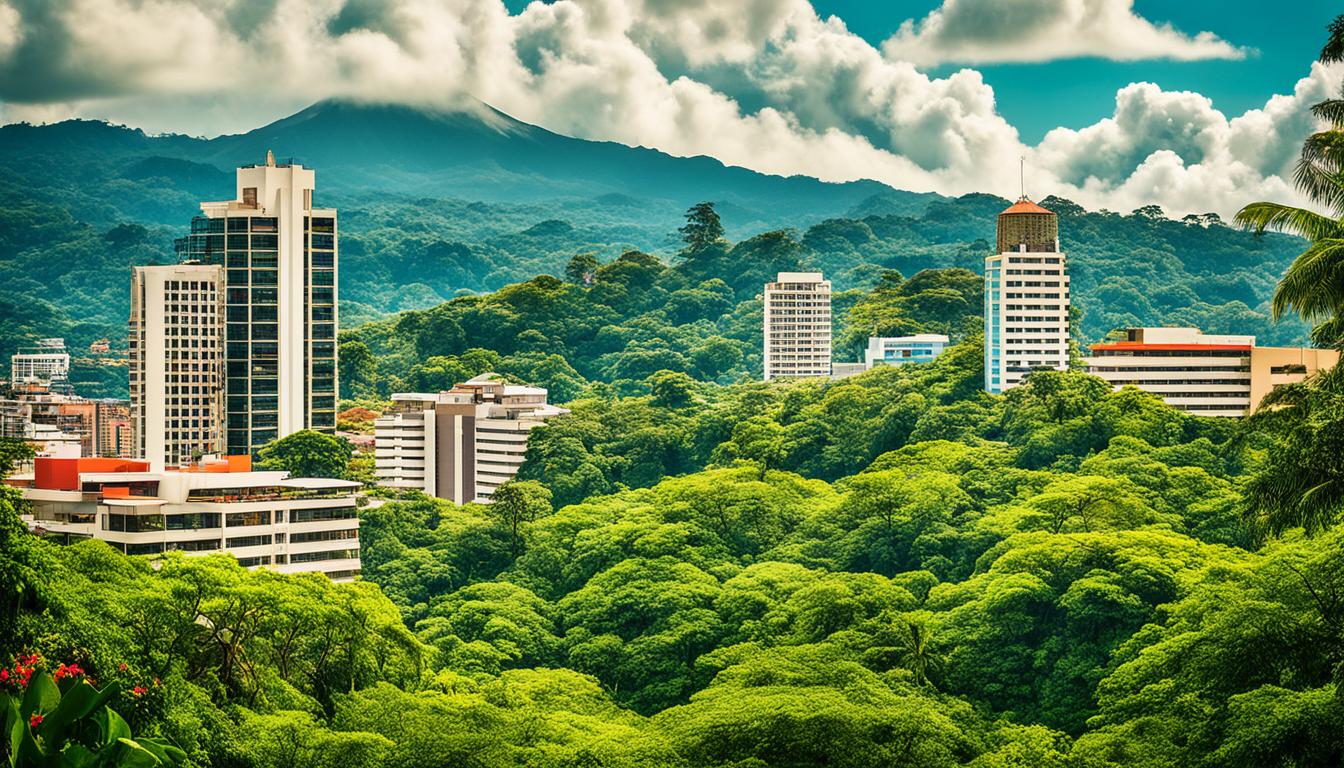Brazil Sacred Natural Sites and Biodiversity
Did you know that Brazil is home to numerous sacred natural sites that are vital for biodiversity conservation and environmental protection?
These sacred sites, found throughout the country, hold deep cultural and ecological significance. They are not just beautiful landscapes, but they also play a crucial role in protecting Brazil’s natural heritage and promoting sustainable development. Moreover, they serve as important cultural landmarks for indigenous communities, who have a spiritual and symbolic connection to these sacred spaces.
Key Takeaways
- Brazil is home to numerous sacred natural sites that hold deep cultural and ecological significance.
- These sites play a crucial role in biodiversity conservation and environmental protection.
- They are important cultural landscapes that hold spiritual and symbolic value for indigenous communities.
- Preserving these sacred sites is essential for maintaining Brazil’s rich ecological diversity.
- By integrating culture and conservation practices, Brazil can achieve sustainable development and safeguard its natural heritage.
The House of Plants: A Haven for Reforestation
The House of Plants, situated in the heart of the Guarani Indigenous land in Southern Brazil, is more than just a gardening center – it’s a sanctuary for reforestation and biodiversity preservation. Nestled within the deforested Mata Atlantica forest, the House of Plants is on a mission to restore and protect the rich ecological diversity of this region.
Within the House of Plants, native seedlings are nurtured and cultivated with utmost care. The indigenous gardening center serves as a crucial hub for reforesting degraded areas within the Guarani’s lands, which have been significantly impacted by deforestation. Through their efforts, the Guarani people are playing a vital role in healing and revitalizing the fragile ecosystem of the Mata Atlantica forest.
“Our goal is not only to revive the forest but also to preserve the biodiversity that thrives within it,” says Chief Añetete. “By growing native seedlings in the House of Plants, we are actively contributing to the recovery of the Mata Atlantica forest and ensuring a sustainable future for generations to come.”
With a deep-rooted understanding of the interconnectedness between nature and culture, the Guarani have successfully reforested vast areas surrounding their indigenous land. Their dedication to preserving the natural heritage of Brazil is a testament to their unwavering commitment to the environment.
The House of Plants stands as a symbol of hope and resilience, reminding us of the power of restoration and the importance of preserving our planet’s precious ecosystems. By supporting initiatives like the House of Plants, we can actively contribute to the reforestation efforts in Brazil and safeguard the biodiversity that thrives within the Mata Atlantica forest.
The Cultural Adaptations of the Guarani
The construction of the gardening center posed cultural challenges for the Guarani people. Traditionally, the Guarani organize their space in harmony with nature, and the idea of growing plants inside a house was initially met with resistance. However, the need for reforestation and the scarcity of raw materials for traditional handicrafts led the Guarani to adapt their cultural practices. The gardening center provided a new source of income through the cultivation and sale of native seedlings, ensuring the preservation of their culture while promoting sustainable livelihoods.
The Importance of Guarani Culture in Brazil
The Guarani culture in Brazil encompasses a rich array of traditional knowledge and practices that have been passed down through generations. Central to their cultural sustainability is the preservation of their handicraft traditions, which serve as an integral part of their identity and livelihood. From intricately woven baskets to vibrant pottery, Guarani handicrafts exemplify the cultural heritage and craftsmanship that have prevailed for centuries.
The cultivation of native seedlings in the gardening center not only provided a sustainable source of income for the Guarani community but also contributed to the preservation of their traditional knowledge. By adapting their cultural practices to include the cultivation and sale of native seedlings, the Guarani successfully ensured the continuation of their cultural heritage while promoting economic sustainability.
Preserving Culture Through Sustainable Livelihoods
“The gardening center allowed us to adapt while still preserving our culture. It is a balance between traditional practices and the need for reforestation. Through sustainable livelihoods, we can maintain our cultural traditions for future generations.” – Guarani Elder
The gardening center not only presented the Guarani with economic opportunities but also allowed them to maintain a strong connection to their cultural roots. The cultivation and sale of native seedlings serve as a bridge between traditional practices and environmental conservation. By embracing the gardening center as a means of sustainable livelihood, the Guarani showcased their ability to adapt cultural practices while preserving their heritage.
Building a Sustainable Future
The integration of the gardening center into the Guarani’s way of life not only helps secure their cultural preservation but also contributes to a sustainable future for the entire community. By cultivating and selling native seedlings, the Guarani actively participate in reforestation efforts, which are essential for maintaining a healthy ecosystem. This sustainable approach ensures the continued preservation of their culture, while also promoting environmental conservation for future generations.
The success of the gardening center highlights the importance of finding innovative solutions that reconcile cultural preservation and sustainable development. By adapting their cultural practices to meet the challenges of reforestation, the Guarani demonstrate their resilience and commitment to both their cultural heritage and the environment.

Contribution of the Gardening Center to Guarani Livelihoods
| Aspect | Impact |
|---|---|
| Preservation of Traditional Knowledge | The cultivation and sale of native seedlings help preserve and transmit traditional knowledge, ensuring the continuity of Guarani culture. |
| Economic Sustainability | The gardening center provides a sustainable source of income, reducing dependence on external resources and contributing to the economic well-being of the community. |
| Environmental Stewardship | By participating in reforestation efforts through the cultivation of native seedlings, the Guarani contribute to environmental conservation and the preservation of their land. |
The Success of Reforestation Efforts
Since its establishment, the gardening center in Brazil has achieved remarkable success in reforestation efforts. Over 20,000 native seedlings have been cultivated in the nursery, and more than 50,000 have been planted in the deforested areas within the Guarani’s lands.
This dedication to seedling production has resulted in the recovery of 30 hectares of degraded areas and the preservation of over three thousand hectares of the native biome. These eco-restoration initiatives have not only restored the forest but also improved the ecological diversity of the region.

The success of the gardening center’s reforestation efforts can be attributed to the production and planting of native seedlings. By prioritizing the use of native species, the center ensures that the reforested areas have a more significant ecological impact, supporting the growth of local flora and fauna.
Our approach to reforestation goes beyond simply planting trees; we focus on ecological restoration that enhances the biodiversity and resilience of the ecosystem. By using native seedlings, we are restoring the natural balance and creating habitats for countless species.
This commitment to ecological restoration through the cultivation and planting of native seedlings is essential for the long-term sustainability of Brazil’s forests and the preservation of its ecological heritage.
The National Sanctuary of Umbanda: Restoring Nature Through Faith
The National Sanctuary of Umbanda, located within the Serra do Mar Ecological Reserve in Santo André, Brazil, is a prime example of the intertwining of spirituality and nature. The followers of the Umbanda religion, aiming to find a natural place for their faith practices, took it upon themselves to restore the degraded area. This sanctuary, which combines elements of Catholicism, African orixás, and local Indigenous beliefs, serves as a sanctuary for rare or endangered species and promotes the restoration of the environment.
The National Sanctuary of Umbanda in Brazil is a unique place where the practice of the Umbanda religion meets environmental restoration efforts. Situated within the Serra do Mar Ecological Reserve in Santo André, this sanctuary exemplifies the harmonious integration of spirituality and nature. Followers of the Umbanda religion, striving to find a natural setting for their faith practices, have taken upon themselves the noble task of restoring the degraded area surrounding the sanctuary. Through their collective efforts, they seek not only to preserve their African cultural heritage but also to protect the sacred natural sites that the sanctuary encompasses.
The National Sanctuary of Umbanda welcomes individuals from various backgrounds who adhere to the Umbanda religion. This inclusive sanctuary combines elements of Catholicism, African orixás, and local Indigenous beliefs. It serves as a haven of spiritual connection and a safe haven for rare or endangered plant and animal species. The restoration activities carried out by the followers of the Umbanda religion contribute to the preservation and enhancement of the natural environment, ensuring the continued existence of these sacred sites for future generations.
By integrating faith and environmental restoration, the National Sanctuary of Umbanda showcases the profound connection between spirituality and nature. This unique approach not only preserves Brazil’s African cultural heritage but also promotes the restoration and conservation of sacred natural sites. The sanctuary serves as a testament to the power of faith and its ability to inspire individuals to act as stewards of the environment. Through their collective efforts, the followers of the Umbanda religion are making a significant impact on environmental restoration in Brazil.

The Role of Sacred Natural Sites in Brazil
Brazil is home to numerous Sacred Natural Sites (SNS) that hold enormous cultural importance and play a critical role in environmental conservation and biodiversity preservation. These sites are revered by various religious and cultural communities and are believed to possess unique spiritual energies. The recognition of the cultural dimensions and spiritual connections to the natural environment is crucial in shaping effective conservation strategies and fostering a deep appreciation for Brazil’s natural heritage.
Sacred Natural Sites in Brazil serve as sanctuaries where cultural traditions and ecological preservation merge harmoniously. They are revered for their cultural significance and spiritual connection with nature. These sites hold immense value in the eyes of indigenous communities, who consider them sacred and protect them as repositories of ancestral wisdom.
“Sacred Natural Sites are not only places of worship but also spaces for ecological conservation. They embody our cultural identity and hold the knowledge of our ancestors, guiding us towards sustainable practices.” – Elder from an indigenous community in Brazil.
These sacred places provide a strong framework for environmental conservation and biodiversity preservation in Brazil. By recognizing the cultural importance of these sites, policymakers and conservationists can develop holistic conservation strategies that integrate traditional knowledge and modern science. This approach ensures the conservation of both cultural heritage and natural ecosystems.
The preservation of Sacred Natural Sites in Brazil is not just for cultural or spiritual reasons; they also have a tangible impact on the environment. These sites act as sanctuaries for unique ecosystems and rare species, contributing to the overall biodiversity of the region. They serve as natural corridors, allowing the free movement of wildlife and promoting ecological balance.
Furthermore, these sites often contain areas with high ecological sensitivity, such as water sources or fragile habitats. Protecting these sites becomes crucial for maintaining the health and resilience of ecosystems, ensuring the survival of endemic species and safeguarding natural resources for future generations.
By recognizing and preserving Sacred Natural Sites in Brazil, we can create a harmonious balance between cultural significance and environmental conservation. This integrated approach fosters a deep respect for nature and encourages sustainable practices that benefit both human communities and the rich biodiversity of Brazil.
Case Study: Sacred Natural Sites in the Amazon Rainforest
The Amazon Rainforest, known for its unparalleled biodiversity, is also home to numerous Sacred Natural Sites that hold immense cultural and ecological importance. Indigenous communities residing in the Amazon have a profound spiritual connection with nature and consider certain locations within the rainforest as sacred.
One of the well-known Sacred Natural Sites in the Amazon is the Yanomami Territory, inhabited by the Yanomami people. They believe that their spiritual connection with the land and its resources serves as the foundation for their cultural identity. The preservation of this sacred land is crucial for the Yanomami people’s physical and spiritual well-being.

| Sacred Natural Sites in Brazil | Cultural Importance | Environmental Conservation | Biodiversity Preservation | Spiritual Connection |
|---|---|---|---|---|
| Yanomami Territory, Amazon Rainforest | Preserves Yanomami cultural identity | Protects the Amazon Rainforest and its resources | Safeguards endemic species and maintains ecological balance | Strengthens the spiritual connection of the Yanomami people with nature |
| Chapada dos Veadeiros National Park | Showcases the cultural heritage of the Quilombola communities | Conserves the unique Cerrado ecosystem | Preserves the endemic fauna and flora of the region | Offers a sacred space for spiritual rituals and healing practices |
| Pico da Neblina National Park | Protects the cultural heritage of the indigenous Tukano people | Preserves the fragile ecosystems of the Guiana Highlands | Conserves endangered species, such as the white-cheeked spider monkey | Provides a spiritual connection to the ancestral lands |
The presence of Sacred Natural Sites in the Amazon Rainforest not only contributes to the cultural diversity of Brazil but also enhances the ecological resilience of this globally significant biome. By recognizing and protecting these sites, Brazil can continue to harmonize cultural importance, environmental conservation, biodiversity preservation, and spiritual connection to create a sustainable future for all.
The Benefits of Integrating Culture and Conservation
The integration of cultural and conservation practices is essential for holistic environmental management in Brazil. By recognizing the immaterial values associated with the environment, such as cultural traditions, beliefs, and spiritual connections, Brazil can enhance its efforts in biodiversity conservation and land preservation. This approach acknowledges the interconnectedness of cultural and natural realms, emphasizing the importance of understanding and respecting cultural values to protect the country’s natural heritage for future generations.
Intercultural conservation Brazil is crucial in fostering a harmonious relationship between different cultures and the environment. It brings together diverse cultural values Brazil, allowing for a comprehensive understanding of the intricate connections between people and nature. Through this integration, environmental management Brazil can adopt a holistic approach Brazil that encompasses not only the scientific aspects of conservation but also the cultural and spiritual dimensions.
By valuing cultural traditions, beliefs, and practices, Brazil can harness the power of cultural values Brazil to drive environmental stewardship. Cultural values act as a catalyst for promoting sustainable practices and influencing individuals to make positive changes for the preservation of natural resources. Environmental management Brazil that incorporates cultural values Brazil creates a deeper sense of ownership and responsibility towards the environment, fostering a collective effort towards conservation.
“The integration of cultural and conservation practices is instrumental in creating a balance between human activity and nature. By recognizing the inherent value of cultural traditions and beliefs, we can work towards a sustainable future that protects both our cultural heritage and the environment.” – Environmentalist Claire Morgan
A holistic approach Brazil also promotes environmental justice and inclusivity, ensuring that cultural diversity is preserved alongside ecological diversity. It acknowledges the importance of indigenous knowledge and traditional practices in sustainable resource management. By incorporating these holistic approaches Brazil, Brazil can create a more equitable and inclusive society that values and respects the cultural diversity Brazil within its borders.
Cultural Values Driving Conservation Efforts
The integration of culture and conservation in Brazil has led to remarkable achievements in environmental preservation. Indigenous communities, in particular, have played a pivotal role in conservation efforts, drawing on their ancestral knowledge and cultural values Brazil. The pursuit of sustainable livelihoods and the desire to protect their cultural heritage have motivated them to engage in projects that promote the conservation of ecosystems and biodiversity.
One example is the sustainable extraction of Brazil nuts in the Amazon rainforest. Indigenous communities have managed these forest resources for centuries, integrating cultural practices and conservation principles to ensure the long-term viability of the Brazil nut trees. By valuing the cultural significance of Brazil nuts and the forest ecosystem, these communities have helped preserve vital habitats and promote biodiversity within the region.
Examples of Cultural Practices Enhancing Conservation Efforts
| Cultural Practice | Conservation Benefit |
|---|---|
| Traditional agricultural practices | Preservation of agro-biodiversity and soil fertility |
| Sustainable fishing techniques | Protection of fish populations and aquatic ecosystems |
| Community-led conservation initiatives | Engagement and empowerment of local communities in environmental preservation |
| Spiritual rituals and ceremonies | Promotion of reverence and respect for natural resources |
The integration of culture and conservation in Brazil exemplifies how embracing cultural values Brazil can enhance environmental management Brazil and foster a deeper connection to the natural world. By recognizing the importance of cultural traditions, beliefs, and spiritual connections, Brazil can ensure the long-term sustainability of its natural heritage while promoting cultural diversity and inclusivity.

Challenges and Future of Sacred Natural Sites Conservation
Despite the significant cultural and ecological importance of Sacred Natural Sites in Brazil, there are challenges that need to be addressed. One of the key challenges is securing sustainable funding for the maintenance and preservation of these sites, including gardening centers and reforestation initiatives. Additionally, there is a need for recognition and legal protection of these sites to ensure their long-term conservation. By addressing these challenges, Brazil can continue to promote the preservation of its sacred natural sites and safeguard its cultural and ecological heritage.
Securing Funding for Conservation Projects
Funding plays a crucial role in supporting the maintenance and preservation of Sacred Natural Sites in Brazil. Securing sustainable financial resources is essential to ensure the ongoing conservation efforts, including the establishment and operation of gardening centers, reforestation initiatives, and other conservation projects. Adequate funding enables the hiring of skilled personnel, procurement of necessary equipment and materials, and the implementation of effective management strategies.
Ensuring Sustainability in Conservation Efforts
Sustainable practices are vital to the long-term success of Sacred Natural Sites conservation in Brazil. It is essential to develop and implement strategies that promote sustainable livelihoods for local communities and stakeholders involved in conservation initiatives. By integrating sustainable practices, such as eco-friendly approaches to reforestation and resource management, Brazil can ensure the continued preservation of its sacred natural sites without compromising the ecological balance or exhausting finite resources.
Recognition and Protection of Cultural Heritage
Recognition of the cultural significance of Sacred Natural Sites is crucial for their preservation. Brazil needs to prioritize the identification and documentation of these sites as part of the country’s cultural heritage. This recognition enhances awareness and appreciation for the role of sacred sites in the country’s diverse cultural tapestry. Additionally, legal protection is necessary to safeguard these sites from encroachment, development, and other threats that could compromise their integrity.
Legislation for Effective Conservation
Developing robust legislation specifically tailored to the protection and conservation of Sacred Natural Sites is essential. Appropriate legal frameworks can provide the necessary tools and mechanisms to enforce conservation measures, delineate responsibilities, and regulate activities that may potentially harm these sites. By establishing clear guidelines and regulations, Brazil can ensure the effective management and long-term preservation of its sacred natural heritage.
By addressing the challenges of securing funding, promoting sustainability, recognizing cultural heritage, and enacting conservation legislation, Brazil can pave the way for the future of sacred natural sites conservation. These efforts will not only preserve the unique cultural and ecological value of these sites but also contribute to the overall sustainability and heritage recognition of Brazil.
The Global Movement for Sacred Natural Sites Conservation
The recognition of sacred natural sites as important conservation areas extends beyond Brazil. The global community is increasingly acknowledging their intrinsic value in biodiversity conservation and cultural preservation. Governments and environmental organizations worldwide are embracing the incorporation of spiritual and cultural dimensions into their conservation strategies, fostering international cooperation and a deeper appreciation for the connection between environmental sustainability, cultural diversity, and environmental spirituality.
In recent years, sacred natural sites have gained global recognition for their role in preserving biodiversity and maintaining ecological balance. These sites, revered by cultures across the world, hold immense cultural and spiritual significance. As the environmental movement continues to evolve, there is a growing understanding that conservation efforts must respect and incorporate the cultural values and beliefs associated with these sites.
Environmental spirituality is a vital aspect of sacred natural site conservation. It recognizes the deep connection between humans and nature, emphasizing the spiritual and metaphysical dimensions of our relationship with the environment. By embracing this holistic approach, conservation efforts can go beyond scientific and economic considerations, nurturing a profound reverence for nature and promoting sustainable practices.
The conservation of sacred natural sites encourages cultural diversity by highlighting the unique traditions, rituals, and beliefs of indigenous people and other cultural communities. These sites serve as living examples of the intimate relationship between diverse cultures and the natural world. Their preservation ensures the continuity of cultural heritage for future generations, fostering a deep appreciation and respect for the rich tapestry of human experience and wisdom.
“Sacred natural sites are spaces where culture and nature converge. They provide a unique opportunity to bridge the gap between local and global perspectives on environmental conservation.”
The global recognition of sacred natural sites as important conservation areas has paved the way for international cooperation. Governments, organizations, and individuals from different countries are coming together to safeguard these sites, offering support and sharing best practices. This collaborative approach strengthens conservation efforts, enabling the preservation of cultural and natural heritage on a global scale.
The Global Movement for Sacred Natural Sites Conservation
- Increased recognition and conservation efforts for the protection of sacred natural sites worldwide.
- Incorporation of spiritual and cultural dimensions into global conservation strategies.
- Promotion of environmental spirituality and its role in fostering a deep connection to nature.
- Preservation of cultural diversity through the conservation of sacred natural sites.
- International cooperation and collaboration in the preservation of sacred natural sites.
Through the global movement for sacred natural sites conservation, the world is embracing the intrinsic value of these sites and recognizing their role in preserving biodiversity, cultural diversity, and environmental spirituality.

Education and Advocacy for Sacred Natural Sites Conservation
To ensure the long-term preservation of sacred natural sites and biodiversity in Brazil, education and advocacy play crucial roles. Promoting awareness among local communities, government officials, and the general public about the cultural and ecological significance of these sites is essential. Environmental education programs that highlight the importance of cultural sensitivity Brazil sacred natural sites can foster cultural sensitivity and inspire individuals to become advocates for their conservation. Through education and advocacy, Brazil can secure the future of its sacred natural sites and promote sustainable practices.
One effective way to raise Awareness Brazil about the value of sacred natural sites is by implementing comprehensive environmental education initiatives. These programs can be designed to engage diverse audiences, including school children, community members, and policymakers. By incorporating environmental education Brazil into the curriculum, students can develop a deep understanding of the importance of environmental conservation and cultural heritage. This knowledge equips them to become informed advocates for the protection of sacred natural sites.
Moreover, educational campaigns can be organized through various channels, such as public awareness campaigns, workshops, and community events. These initiatives can highlight the role of sacred natural sites in maintaining ecological balance, preserving biodiversity, and promoting sustainable development. By emphasizing the interconnectedness of nature, culture, and spirituality, these campaigns foster a sense of responsibility and appreciation for the environment.
By educating individuals and communities, cultural sensitivity Brazil awareness is raised about the environmental and cultural value of sacred natural sites, encouraging proactive conservation efforts.
In addition to education, effective advocacy is necessary to ensure the preservation of sacred natural sites. Advocacy involves raising awareness and influencing decision-makers to support policies and legislation that protect these sites. Non-governmental organizations (NGOs) and community-based organizations can play a significant role in advocating for the rights of indigenous communities and promoting the conservation of sacred natural sites.
Advocacy efforts can be focused on promoting advocacy Brazil the recognition of sacred natural sites as important areas for conservation and sustainable development. This can be achieved through collaborative partnerships with government agencies, indigenous groups, and environmental organizations. Together, these stakeholders can work towards the establishment of protected areas, the development of sustainable tourism initiatives, and the integration of traditional knowledge and practices into environmental management strategies.
By combining education and advocacy, Brazil can effectively address the challenges faced by sacred natural sites and ensure their long-term preservation. This holistic approach emphasizes the cultural and ecological significance of these sites, promoting Awareness Brazil environmental education, cultural sensitivity Brazil advocacy, and sustainable practices to safeguard the country’s natural and cultural heritage.
Examples of Sacred Natural Sites Education and Advocacy Initiatives
Several organizations in Brazil are already leading the way in education and advocacy for sacred natural sites conservation. Here are two notable examples:
- The Amazon Environmental Research Institute (IPAM)
- The Sacred Land Film Project
IPAM has been actively promoting awareness about sacred natural sites in the Amazon region. They organize workshops and educational programs for local communities, providing training on sustainable resource management and environmental conservation. Through these initiatives, IPAM seeks to build capacity among indigenous and traditional communities, empowering them to advocate for the protection of sacred natural sites.
The Sacred Land Film Project uses documentary films and storytelling to raise awareness about the cultural and ecological significance of sacred natural sites. Their films highlight the experiences of indigenous communities and the threats they face. By sharing these stories, the Sacred Land Film Project aims to inspire action and support for the conservation of these unique landscapes.
| Education and Advocacy for Sacred Natural Sites Conservation | Benefits |
|---|---|
| Increased awareness and knowledge about the cultural and ecological value of sacred natural sites | Develops a sense of responsibility and promotes community engagement in conservation efforts |
| Strengthened advocacy for the legal recognition and protection of sacred natural sites | Influences policy-making processes and promotes sustainable practices |
| Empowerment of local communities and indigenous groups | Fosters self-determination and strengthens cultural resilience |

Conclusion
The intertwining of spirituality and nature in Brazil’s Sacred Natural Sites reflects the deep cultural and ecological significance of these areas. By recognizing and preserving these sites, Brazil can promote cultural conservation, biodiversity preservation, and sustainable development. The success of projects like the House of Plants and the National Sanctuary of Umbanda demonstrates the positive outcomes of integrating culture and conservation. With continued efforts in education, advocacy, and sustainable funding, Brazil can ensure the long-term preservation of its sacred natural sites and protect its environmental heritage.








